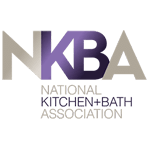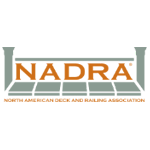Your dream kitchen starts with the right kitchen floor plan. In this article, we break down kitchen layout types and styles with practical tips from interior designer Natalia Zieba. Plus, learn how to use free 3D kitchen planner tools and see kitchen ideas come to life with short videos.
Included in this article:
What’s a Kitchen Floorplan?
A kitchen floor plan shows the arrangement of cabinets, counters, sink and major appliances in a given space. That’s the simple definition, but as anyone who has undertaken kitchen design or redesign knows, managing the multiple elements of a modern kitchen is challenging.
That’s why kitchen floor plan tools are so helpful in designing a kitchen layout, says Natalia Zieba, interior design and training lead for 3D Cloud, a 3D innovation company.

Natalia Zieba
“One of the main components that makes a good kitchen layout is a workable triangle,” says Natalia Zieba, Interior Design and Training Lead for 3D Cloud, a 3D design, and visualization innovation company.
The triangle is the relationship between the refrigerator, stove, and sink. In this design, place the appliances where they can provide maximum convenience and functionality. The rule of thumb is to set the distance between the three work zones between four feet and nine feet. The sum of the three sides lying between the appliances should be 13 feet and 26 feet. Another aspect of work triangle planning is to think of workstations and include useful countertop work surfaces.
“The layout is the primary element in kitchen design,” Zieba says. We don’t update or remodel kitchens often because of the expense and disruption — every five to ten years at the most.”
You can present kitchen designs in three main ways:
- Simple Kitchen Floor Plan Sketch: You draw it by hand with a pencil, graph paper, and straight edge. Eventually, you may want to graduate to more detailed floor plans using modeling tools.
- 2D Kitchen Floor Plan:A 2D diagram still renders the kitchen floor plan as a flat drawing but provides a better illustration than a hand-drawn sketch. Most floor plan tools and apps provide a library of basic kitchen shapes and components to pull into your floor plan.
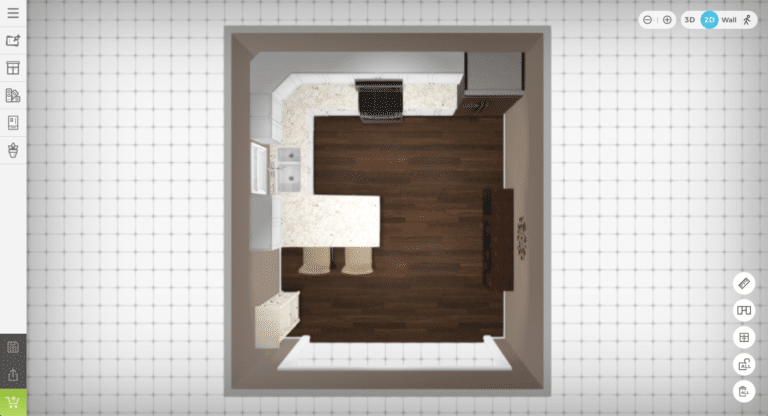
Sample 2D Open Floor Plan Kitchen
- 3D Kitchen Floor Plan:3D floor plans are ideal for visualizing an entire room, including cabinets, appliances, colors, textures, and materials. They provide more detail than a 2D floor plan because they approximate how your new kitchen will look in real life. Here’s what a 3D floor plan looks like:
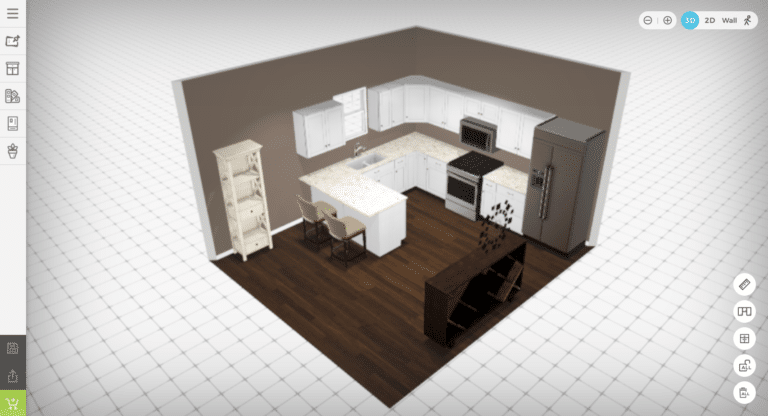
Sample 3D Kitchen Open Floor Plan
“The biggest trend over the last few years is open-concept kitchens — it’s all about bringing people and the home together,” notes Zieba. “Having a multifunctional kitchen in which everyone feels comfortable means a lot, and it’s one that’s perfect for hosting parties and entertaining.”
Next, we cover the types of kitchen floor plans, including open-concept kitchens and much more.
Types of Kitchen Floor Plans, Plus Pros and Cons
Different types of kitchen floor plans arise from the available space. Sometimes, you have options within a given space, like adding an island. Basic kitchen floor plan types range from galley kitchens to L and U shapes, open-concept kitchens, island designs, and more.
Single-Wall Floor Plan (Straight)
Single-wall layouts address space concerns for small condos, lofts, mother-in-law units, tiny houses, and mobile homes. With this design, you can gain more workspace and seating with a stationary or movable island. Another option is to use all the wall space and build up to add more storage and visual interest.

Single-Wall Kitchen Floor Plan
Pros: Single-wall kitchens can be extremely efficient and cost less than other floor plans, depending on the components. The absence of a work triangle means you move laterally through the space instead of turning to reach needed items or areas. You can replicate the work triangle feeling by adding a table or island.
Cons: You must be savvy in using materials, carefully consider storage needs, and be judicious about what you store in the kitchen. Maintain space between the various work elements of your kitchen so you’ll have room for food preparation or other tasks (including task overlap).
Galley Kitchen Floor Plan
Galley kitchens, also called parallel or corridor kitchens, are longer than they are wide. Two parallel cabinet runs create a central corridor in a galley kitchen. This floor plan saves space but can be inefficient without careful design and planning.
Many home chefs prefer galleys because they work well with the classic work triangle. Galley layouts are ideal when you need doors or entryways at both ends of the kitchen.
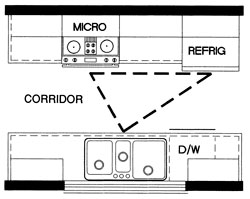
Galley Kitchen Floor Plan
Pros: A galley kitchen has a functional layout with everything within easy reach. It is an excellent fit for small homes because it offers a functional workspace and exit points.
Cons: This layout is narrow and can often be tight and dim. Depending on the length of the kitchen, it may have limited counter space. This design is often not conducive to having more than one person preparing food. If space allows, add a table or island between the two counters to create more prep space.
The G-Type or Peninsula Kitchen Layout
The G-type, sometimes called a peninsula kitchen layout, is an alternate version of the U-shaped kitchen. This layout can make your kitchen more inviting, expand the workspace, and increase surrounding storage options on three sides. Two usable countertop sides provide a work surface or breakfast bar, or alternately, two sides for work and visible storage.
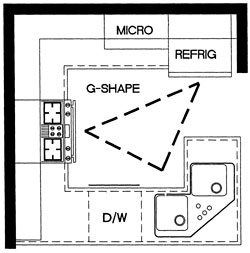
G-Type Kitchen Floor Plan
Pros: Three side walls provide space for kitchen cabinets, food, small appliances, and utensil storage. This floor plan offers two options: Raise one wall for more privacy or break through it to open it up and connect to other living spaces. Depending on the square footage, you can implement a work triangle option, which accommodates multiple cooks.
Cons: In homes designed in the 1960s through the 1980s, these kitchens can feel small due to cabinet units hanging over the peninsula. The corner base cabinets in G-shaped kitchens are often dead space that requires special storage solutions. If there isn’t ample space, this layout can also limit access to the kitchen for multiple cooks or guests.
L-Type Kitchen Floor Plan
The L-shaped kitchen plan is a popular classic because its flexible design can adapt to many kitchen sizes and decors. The ergonomically friendly kitchen design fits well into a 10-by-10 kitchen footprint, which is the benchmark for cabinets and counter cost estimates.
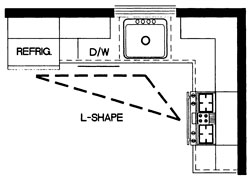
L-Shaped Kitchen Floor Plan
The Pros: This layout offers efficiency and costs less than more complex designs. Adding a table or island (movable or stationary) creates a more ergonomically efficient kitchen triangle.
The Cons: Some homeowners may find it inconvenient to walk back and forth from their stove, sink, and refrigerator. Depending on square footage, multiple cooks may find this layout awkward to navigate. Corner base cabinets may be a chore to use unless there are accessories in place that enhance functionality.
U-Type Kitchen Floor Plan
A U-shaped layout features a closed-off galley. Adding a kitchen island can increase functionality, but many older U-type kitchens don’t have enough space. For an island to work well, you need at least 3.5 feet between the island, surrounding cabinets, and appliances. This extra space gives doors enough allowance, and people can easily use and move through the kitchen.

U-Shaped Kitchen Layout
Pros: A single cook can work seamlessly in any U-shaped size kitchen. The design offers ample storage and counters on three sides, so there’s typically plenty of room for adequate food preparation and cooking.
Cons: A U-type kitchen’s constrictive nature makes it impossible to accommodate a kitchen table and chairs or even a small island. Additionally, depending on the position of the sink, the dishwasher may not fit next to it. Accessing bottom-corner cabinets is challenging, and workstations can be too far apart.
Single-Island Kitchen Floor Plan Design
Islands are all the rage in kitchen layouts. The average size of a kitchen island measures 3 by 6.5 feet and should have at least 42 inches of clearance for a walkway. When adding an island, a kitchen should be approximately 12.5 feet to 13 feet from wall to wall to allow for cabinetry on both walls and a walkway on either side.
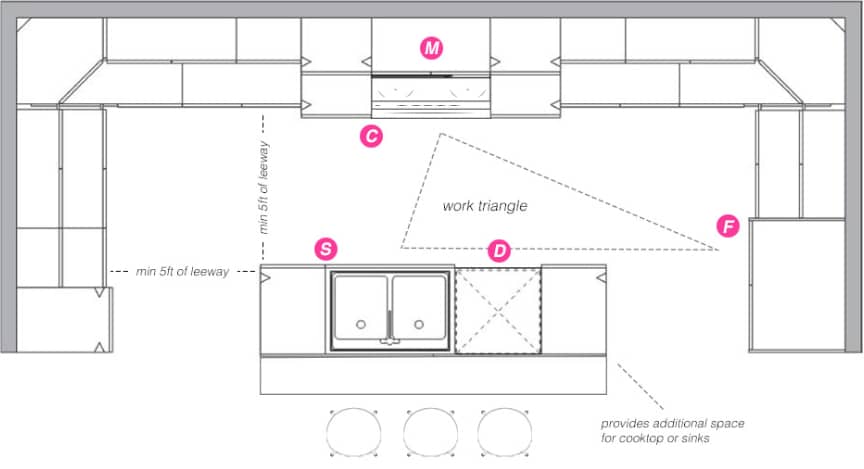
Single-Island Kitchen Floor Plan
Pros: Kitchen islands are popular because they provide extra counter space and can be used to serve guests buffet-style meals. This layout adds seating and is an attractive way to define space in open-concept designs.
Cons: An island can break up the classic work triangle. You can keep the work triangle intact by placing dishwashers or cooktops on the island. While this offers a solution, cooktops can be hard to vent, and the hot surface can also be dangerous for children and adults.
Double-Island Kitchen Layout
Two islands are a luxury option in large, newer homes with open floor plans. With a smart layout and configuration, two islands in a kitchen can improve traffic function and flow.
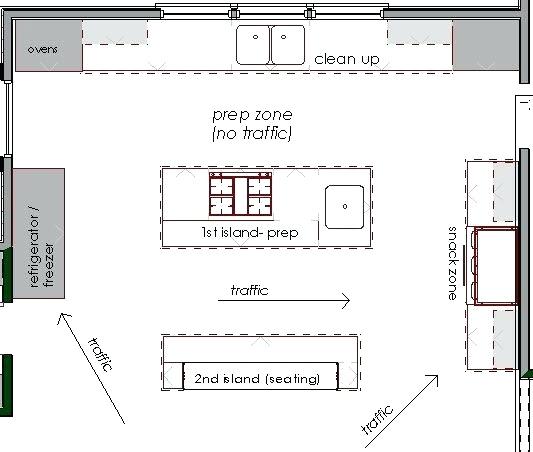
Double-Island Kitchen Floor Plan
Pros: If you have a big family, entertain a lot, or need more storage and seating, the double island can be a bonus. The design can divide the kitchen into different functions, such as a prep sink and baking area on one island and stools and a serving area on the other. Having two islands can fill a vast space for improved balance. Plus, finding natural stone like granite, marble, or quartz to fit the island seamlessly is easier.
The cons: A double island setup will cost more and require lots of space. Continuous counter space for serving buffet style may be lost. Two islands may require more cleaning and tidying.
Corner-Type Kitchen Floor Plan
A cousin of the L-shaped layout, the corner-type kitchen floor plan provides open space and functional upper cabinets.
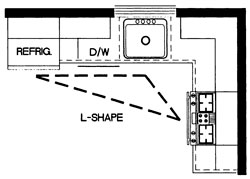
L-Shaped Kitchen Floor Plan
Pros: Tucking your kitchen into a corner can automatically expand a previously closed space and make a home feel larger than before. Adding a table or an island adds more functionality.
Cons: The traditional triangle arrangement is lost without an island or an additional piece of furniture. You may have to move around the kitchen more than you’d prefer to complete meal prep.
Modern/Open Kitchen Design
The open kitchen is a significant trend that is featured regularly on home makeover shows because its design is more flexible. The concept began post-World War II when home life took a more casual turn. With an open-plan kitchen, colors and style choices should be consistent with the rest of the home.
Cons: An open kitchen does not offer privacy. Everyone can see how you’re preparing food. Cooking smells, strong odors, and smoke permeate other rooms in the home, and noise from other rooms easily makes its way into the kitchen. This may not be a good fit if you like to tend to your cuisine in peace while the rest of the family enjoys rowdy games or loud TV. In this design, you cannot close off your kitchen while you cook.
Kitchen Layout Planning Factors
A good kitchen floor plan needs to account for many factors. These include obvious ones like aesthetics, functionality, and cost and more technical aspects like building codes and what’s behind the walls.
“You must consider plumbing, wall structures, electrical lines … it’s not a simple process,” Zieba says. “To ensure a good result, an option is to hire a designer or work with kitchen experts at your local kitchen showroom.”
First, it’s useful to think through exactly what you want and need in your new kitchen, whether you have help from designers or contractors.
Kitchen planning elements to consider include:
- State and local building codes and permits: Follow the rules for your safety, whether tackling a kitchen project or working with a contractor. If you sell someday, the home must be inspected, including code requirements for electrical, plumbing and ventilation elements, stairways, and railings. Your city’s building department, which is the final authority, will provide state and local code standards.
- Cost and budget: Work back from what you can afford before starting any kitchen design.
- Lifestyle: Think about how you live daily or how you want to live. Consider how often and how many people you entertain, whether you usually eat in the kitchen and how kids and other family members use the space. For example, if you or your family members have mobility issues, you will want to ensure that space between the cabinets and counter heights accommodates their needs.
- Functionality and use patterns: Consider what’s missing now and what you’ll likely need. For example, consider where to locate an island or other items to improve flow, storage, and favorable working conditions in your kitchen.
- Appliances: Pick appliances that work with your lifestyle. Today, many features are available, including smart appliances, under-counter refrigerators, freezers with a cleaner visual profile, and column refrigerators that let you configure cooling spaces and offer odor seals.
- Cabinetry: Ensure that the cabinetry harmonizes with the design of your home, even if your kitchen lives behind a door. Cabinets will take up a large part of your kitchen budget. So, it’s essential to comparison shop, get samples, and do some pre-visualization before making a purchase.
- Lighting: Consider the natural light in your kitchen. If the space is dark and the budget allows, add wall windows or skylights to improve work light and the aesthetic appeal during the day. If you’re adding artificial lighting, create enough ambient lighting for the evening, and determine what type and how much illumination you need for workstations. Under-cabinet lights can be an attractive, low-cost addition to your kitchen. Using dimmers for ambient lighting is a nice touch, particularly in more open, multi-use kitchen floor plans. Remember to use energy-saving bulbs and fixtures.
- Square Footage: You can gain kitchen space by incorporating the existing dining, living, or other nearby rooms. The open-space design trend means that interior walls are coming down in homes. For many families who lead a casual lifestyle, taking space from a formal dining room is a painless way to create a more welcoming, hub-of-the-home kitchen.
Kitchen Floor Plan Design Tips
It pays to research kitchen designs and listen to the pros before developing a floor plan for your new kitchen or remodeling project. Consider your style and needs to create a kitchen floor plan that best fits you, your family and your home.
“A kitchen that has character and stands out is now the new goal,” explains Zieba.
Let’s start with practical advice about kitchen functionality with the work triangle concept.
Use the Kitchen Work Triangle Concept for Your Floor Plan
The kitchen work triangle illustrates the positioning of the refrigerator, stove, and sink. Use this concept to place the three items for maximum convenience and functionality. The rule of thumb is to set the distance between each at 4 to 9 feet. The sum of the triangle’s three sides should be 13 to 26 feet.
Another aspect of work triangle planning is thinking of workstations. You need usable counter space for food prep. Visualize how you will perform common tasks like pulling produce from the refrigerator, washing it in the sink, and chopping it on a cutting board on your counter. Consider the space you’ll need to juggle multiple tasks. The work triangle defines where you’ll do it all and how you’ll move around.

Design of a work Triangle
Consider Kitchen Traffic Patterns and Available Space
How the cook moves around in the kitchen is a key point. But also consider what happens if a second person is cooking or helping. And what about family members entering the kitchen to get something or perform a quick task? Finally, what about visitors? Kitchens can often become a gathering spot. As you develop your kitchen floor plan, consider these traffic patterns and your lifestyle.
“I’ve developed kitchen designs that range from tiny efficiency kitchens to mega-kitchen masterpieces,” says Zieba. “The measure of success is always how well the space works for the specific owner: serious cooks, busy hosts, families whose kids do their homework in the kitchen, those who dine casually and have a formal dining room that sits empty — or all of the above.”
Reflect on What Kitchen Floor Plan Will Satisfy You in Coming Years
It’s easy to get caught up in trendiness or one specific kitchen item that might not mean nearly as much to you in a year. Take a more holistic approach to your kitchen design and how it will work for you and your family now and in the coming years.
“Where do you spend the most time at home?” asks Zieba. “These days, it’s often the kitchen, which is the new living room. If the space doesn’t function, you’ll wish you had a different kitchen, and that makes no sense, logically or financially. My job is to create spaces that will work for years to come.”
Make sure your satisfaction lasts with a smart floor plan. The best reason to remodel is to get the kitchen you want. If you do sell your home, you will recoup an you will recoup an average of 50-60% of your remodel cost of your remodel cost, according to one recent study. So, while you may hear conflicting statistics about the resale value created by kitchen remodels, the best advice is this: Make sure your remodel satisfies you.
Choose Appliances Wisely
Research the various appliances, functions, and brands. There’s a lot to choose from. Visit appliance stores to see and touch appliances and read reviews. They vary widely in price, and while some look nice, they may not be as reliable and durable as others.
Consider questions like: How do I want the refrigerator’s cooling and freezer compartments arranged? What capacity do I need? Do I want a combined range and oven or separate wall ovens? What ventilation do I need? What brands do I trust?
Place the Stove on an Exterior Wall for Best Venting
The best ventilation comes with hoods venting directly outside the home. If that’s an option, take advantage of it. In some homes, especially interior condos, it may not be. In those cases, get the best ventilation to avoid lingering smoke and smells in your kitchen and home.
Consider Integrated and Built-in Designs
Consider cabinetry and appliances that work seamlessly together for a more polished look. Integrated appliances, like refrigerators and freezers, are embedded within the cabinets and often use panels matching the cabinets. This creates a sleek look. However, it also may limit you when you need to replace the appliance, while a freestanding refrigerator is easier to replace.
Maximize Usable Counter Space
You never hear anyone complain about too much counter space. However, without good organization, the typical kitchen can quickly become cluttered with small appliances and other items, leaving little room for the cook to work.
Place Your Sink Wisely
Some designers advise starting your kitchen layout with sink placement since the cook of the house spends so much time there and needs to constantly between it, the refrigerator, the stove, and the prep areas.
Consider a Pot Filler
Consider installing a pot filler near your cooktop to avoid lugging water-filled pots from the sink.
Add Smart Storage Solutions
Incorporate smart storage solutions like small-appliance storage “garages,” pull-out pantry shelves, swing-out corner shelves, and hidden device charging stations in drawers.
Plan Landing Space for Hot Items
Ensure there is enough landing space near appliances like ovens and microwaves to place hot items quickly. Allow at least 15 inches of countertop space on each side of key appliances.
Plan Knife Storage
Plan a knife drawer or install a magnetic strip to attach them above your countertop prep area. This not only keeps knives easily accessible but also keeps them out of reach for children’s safety.
Design for Easier Cleanup
Design your kitchen for easy cleaning by opting for glass refrigerator shelves that catch spills, flush-set or under-mount sinks that are easier to clean, and matte finishes that show less dirt than glossy ones.
Consider Island Functionality
When designing a kitchen island, consider its function. Plan enough space for safe cooking and eating, separate from the dining area. You can also install a sink, range top, or dishwasher on the island.
Tips for Using Floor Plan Tools to Design Your Kitchen
Some kitchen design tools have better functionality than others, so we’ve written these tips to help you choose the right kitchen planning tool and then use any tool well.
Choose the Right Kitchen Floor Plan Tool for the Job
When choosing the right planning tool for your kitchen design job, consider the following tips:
- Ease of Use: Select a kitchen planning tool that is user-friendly and intuitive, especially if you are not technically skilled. Look for features like drag-and-drop components, templates, and easy alignment tools to simplify the planning process.
- Customization Options: Some tools allow you to select different colors and textures for countertops, flooring, and more. This will let you personalize your design according to your preferences and style.
- 3D vs. 2D: Decide if you want more details and visualization with 3D kitchen floor plan tools.
- Collaboration Features: If you plan to work with a team or seek input from others, select a tool with collaboration features. Look for options that allow others to edit, comment, and share feedback.
- Integration and Sharing: To streamline your workflow, consider tools that integrate well with other apps or file storage systems. Look for options that allow you to save files directly to existing setups and easily export designs in various formats, such as PDF or common image formats.
- Support and Learning Curve: Check if the tool provides adequate support through calls, chat, or email. Additionally, assess the tool’s learning curve to ensure it aligns with your skill level and time availability.
Start by Entering Your Setup Information Like Room Dimensions
Most tools have you input your room dimensions, walls, windows, and scale. This information defines the footprint you will work within.
Visualize in 3D If It’s Available
Use the 3D view feature (if included) to see your kitchen design in three dimensions. This allows you to get a realistic representation of how your kitchen will look once it’s built, helping you make informed decisions about the layout and design.
Use the Kitchen Planner’s Component Shapes (or Images)
Take advantage of the illustration libraries available in kitchen floor plan tools to easily incorporate cabinets, drawers, sinks, refrigerators, ranges, ovens, and dishwashers into your design. This feature allows you to visualize the placement of each accurately. One advanced tool from 3D Cloud, even enables you to place 2D items from actual photos into your floor plan.
Experiment with Cabinetry Options
Explore different cabinetry options within the floor plan tool, such as base units in various widths and wall units in different heights and widths. Additionally, consider incorporating tall cabinets for refrigerators or ovens, sink cabinets, and cooktop cabinets to customize your kitchen layout.
Incorporate Countertops and Backsplashes
After selecting cabinets and appliances, remember to add countertops, backsplashes, flooring, and wall colors to complete your kitchen design. These elements play a crucial role in enhancing your kitchen space’s overall look and functionality.
Try Different Kitchen Layout Shapes in the Planner
Think about how you might use your space differently and incorporate a different shape, like a galley, L-shaped, U-shaped, open-concept, single-island or double-island. If your space is limited, can you push your kitchen into a formal dining room? The kitchen planner allows you to visualize your kitchen in new ways.
Kitchen Floor Plan Design Styles
Your kitchen design style will influence your kitchen floor plan and vice versa.Here are some examples of different interior decorating styles for kitchens, ranging from farmhouse and contemporary to coastal and traditional.
Country Farmhouse Kitchen Design:
Thanks to Joanna Gaines of HGTV’s “Fixer Upper,” farmhouse style is all the rage. Distressed antiques, reclaimed and repurposed treasures, and crisp white shiplap walls add a rustic touch. Farmhouse-style kitchens feature painted cabinetry, open shelving, apron-front sinks, and collectibles.
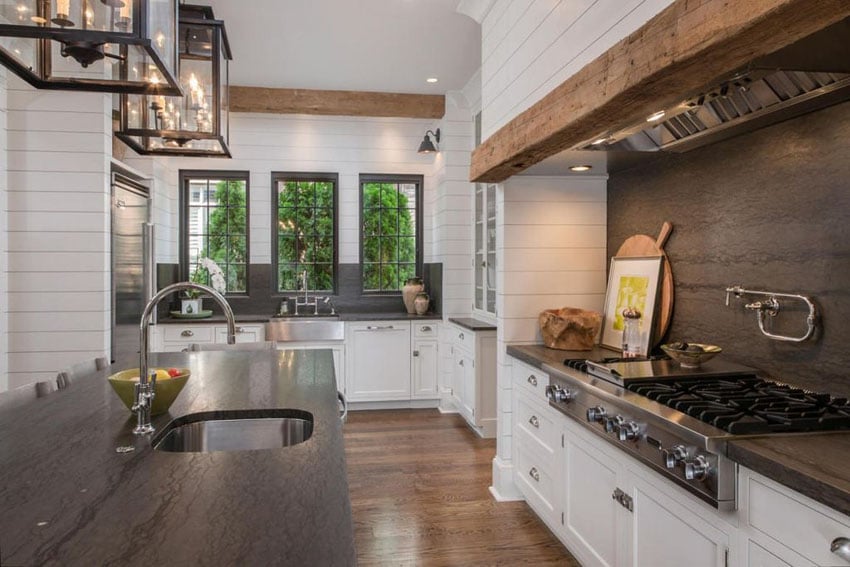
Country Farmhouse Kitchen Design
Contemporary Kitchen Design:
Modern design features clean, open spaces and clean lines. Human-made materials like stainless steel, plastic, concrete, laminate, and glass are incorporated into contemporary kitchen designs.

Contemporary Kitchen Design
Cottage Kitchen Design:
This style combines craftsman, farmhouse, and country elements with functionality. A cottage design creates light, bright, and airy spaces. Since many cottage interiors have an eclectic edge, color is a unifying factor in the design.
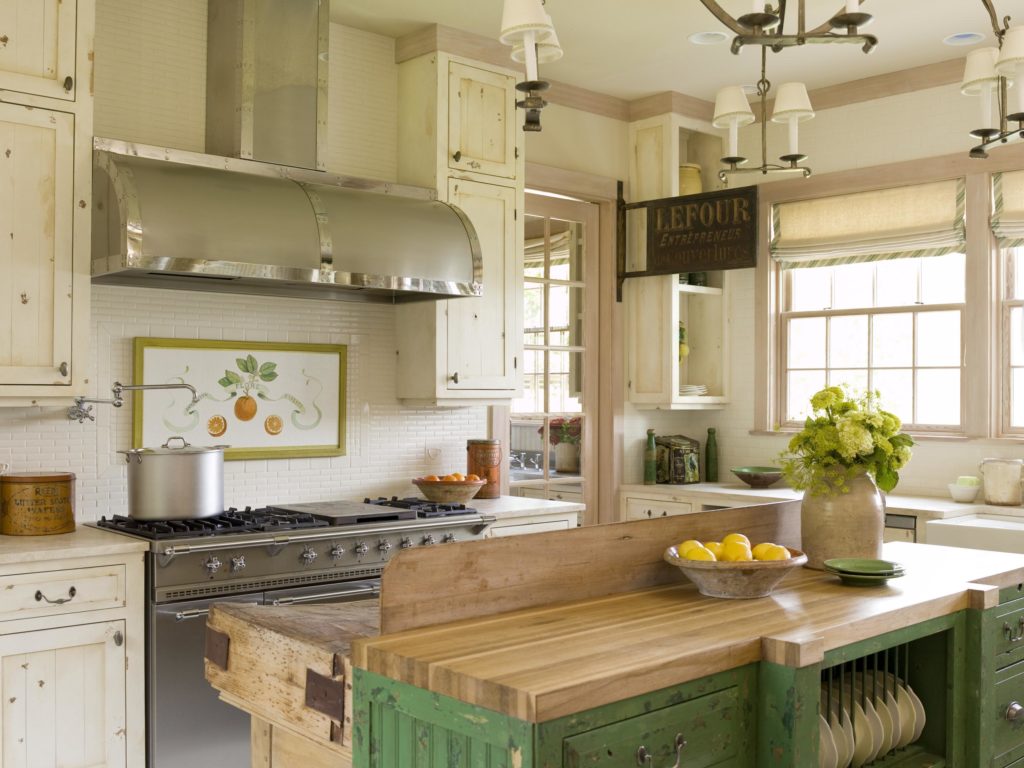
A Cottage Kitchen Design
Mediterranean or French Country Kitchen Design:
European traditional-style kitchens feature furniture-like cabinetry, natural stone countertops, and wood floors. Color palettes are vibrant and bright, with deep red, olive, and gold tones. Rich wood textures, ornate accents, beamed ceilings, and exposed brick tell a story of heritage and homey refinement.
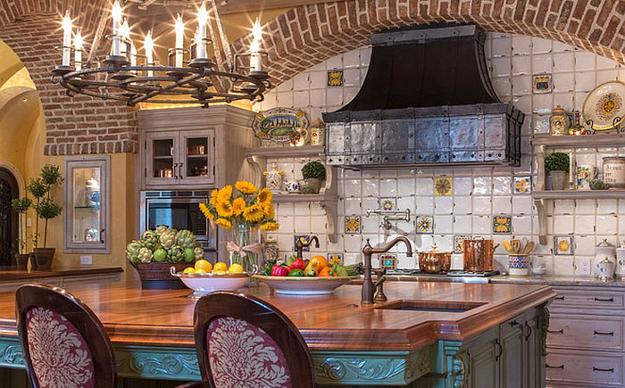
French Country Kitchen Design
Coastal Kitchen Design:
Cream and white are the predominant base colors in a coastal design. Adding colors like seafoam green and distressed wood surfaces adds to the beachy ambiance.

Coastal Kitchen Design
Traditional Kitchen Design:
This kitchen style typically includes decorative touches like raised panel doors, corbels, moldings, and appliques. Traditional kitchens are more formal than other designs. They often use built-in appliances, such as custom wood-panel refrigerators, along with high-end wall ovens, custom cabinetry, and elegant light fixtures.

Traditional Kitchen Design
Transitional Kitchen Design:
The transitional kitchen combines modern and traditional design elements. The goal is to balance the embellishment of traditional design with today’s new trends, materials, and paints without being futuristic or stark.
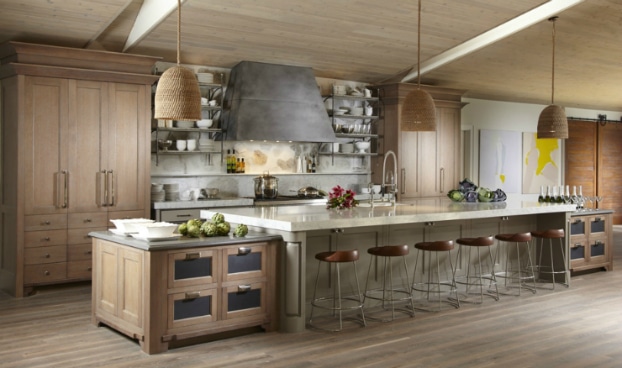
Transitional Kitchen Design
In addition to interior design styles, you must consider other elements as you develop your kitchen floor plan.
Kitchen Design Elements That Add Style
Expressing your style is about what you like, so don’t be afraid to embrace color. Select hues and finishes that suit you.
“It’s all about color in the next few years: white kitchens are out,” Zieba says. “We see new trends with different color appliances, cabinet finishes, and backsplashes. When it comes to flourishes, brass and different kinds of metals with traditional designs are popular for accessories like handles, as well as sinks and faucets.”
Here are some design elements that can add personality to your new kitchen:
- Paint: Can visually open space or make it more intimate. Match or harmonize the paint in your kitchen with other colors in your home.
- Lighting and Windows: Natural lighting in your kitchen can make the difference between a welcoming space and a gloomy one. Consider adding windows or opting for a skylight to bring in light from the outside.
- Ceilings: Make a statement with what’s overhead. Wooden beams add character and architectural definition. Adding a design to the ceiling can also cover cracked drywall and plaster. Tiles are a clean option for busy kitchens, while Victorian tinwork, seen in 19th-century homes and public spaces, can take ceilings from bland to bold.
- Flooring: Wood or materials that look like wood is an ongoing trend that shows no sign of going away. Choose hard-wearing material that’s easy to clean.
- Handles and Plumbing Fixtures: Select finishes that add visual interest, personalize the space, and support the kitchen’s style.
- Countertop and Backsplash Finishes: A matching backsplash and countertop are not a design requirement. Contemporary interior decor styles use metals of all kinds for countertops, backsplashes, and sinks.
- Storage: From incorporating antique buffets into your design to using open shelving to keep dishes handy, storage solutions are getting a makeover. Built-in knife slots in a kitchen’s butcher-block island keep culinary tools handy, while pull-out shelves in cabinets keep pots and pans more visible and reachable.
- Furniture Styles: The tables, chairs, and other furniture in your kitchen don’t need to match. Selecting eclectic items is the trend in every type of décor. The key to this type of design is ensuring the pieces you pick work in harmony with the style of the rest of your home.
- Kitchen Woodwork and Details: Customizing kitchen cabinets is an easy way to make them your own. Replacing cabinet fronts with glass to display eye-catching kitchen items opens the space and adds some flare. Another popular option is to insert metal mesh into cabinet fronts and use copper and brass hardware to complete the look.
- Extra Dining Space: As the activity moves to the cooking center of the home, a peninsula or island can add much-needed tabletop areas.
- Ergonomics: The key in ergonomics is to design a functional space that optimizes human movement and minimizes the body’s tension and stress while completing daily activities in the kitchen. Ideally, the kitchen layout should shorten the distances needed to complete daily tasks.
- Taking Down Walls: The most dramatic change you can make is to remove a wall to open the space to light and other living areas. Before removing a wall, determine if it’s load-bearing. If so, you may need to invest in the help of a structural engineer for added safety.
Common Kitchen Floor Plan Mistakes
Planning your new kitchen with an awareness of the common pitfalls will save you time, money, and aggravation.
“One of the biggest pitfalls I see is when the homeowner tries to economize in the wrong areas,” advises Zieba. “For example, remodelers will order expensive cabinets, but settle for a basic white sink with laminate countertops, saying they’ll upgrade later. It doesn’t happen for years — if ever. Quality wins every time and is worth the investment.”
To help with your decision-making process, here are some common pitfalls in kitchen layout planning to avoid:
- Not asking experts for help: People in the design field have years of expertise that can prevent expense mistakes.
- Wasting counter space: Use corners and appliance garages, and ensure overhead cabinets don’t impede counter use.
- Not enough power outlets: Consult with an electrician to ensure you have an adequate power supply and outlets to handle future needs.
- Inadequate plumbing: Most do-it-yourselfers can’t handle the plumbing or replumbing to accommodate today’s sinks and appliances.
- Poor ventilation: If you’re installing a high-end range or an open-concept kitchen, make sure you have adequate ventilation to remove smoke and odors.
- Misplaced AC and heat vents: Ensure the proper positioning so you’re comfortable year-round in your kitchen.
- Wrong counter height, cabinet height and appliance height: Calculate your ideal heights before planning your kitchen. Otherwise, you’ll need to do with excessive reaching or bending for years to come.
- Not enough storage: You may aspire to Marie Kondo minimalism, but you’ll probably need more storage, not less.
- Too much open shelving: Great in theory, not so much in practice, at least for most people.
- Impractical handles and knobs: Make sure they’re functional and durable.
- Appliances with features you’ll never use: Get durable appliances that do what you need them to do.
Free 3D Kitchen Floor Plan Tools
Are you ready to try a free 3D kitchen floor plan tool? Here is the Lowe’s powered by 3D Cloud.
“The customer journey is fun and very engaging with the 3D Cloud app,” Zieba says. “The program walks you through the floor plan drawing process. Then, choose cabinets you love and place them directly into your floor plan. Alternatively, you can browse inspirational photos and add cabinets directly from the photos to the floor plan by tapping the cabinets that you like to bring them into your virtual kitchen.”
Zieba adds: “The process reminds me of an Ariana Grande song, in which she sings, I see it. I like it; I want it, I got it. In twenty to thirty minutes, from the comfort of your home, you can see what your new kitchen will look like. And in a sense, it gives you ownership, and it’s almost as if you almost got it.”
3D Floor Plan Tools for Kitchen Retailers and Manufacturers
Kitchen retailers and manufacturers are increasingly using 3D kitchen planning tools to help consumers visualize their products in the consumer’s dream kitchen.
The 3D Cloud Kitchen Designer includes Design from Photo technology with an option for Automated One-Click Kitchen Design. Learn how to add objects from a 2D picture to 3D kitchen floor plan with the 3D Cloud Kitchen Designer.
Forward-thinking companies have already turned to the 3D Cloud Kitchen Planner to enhance in-store and virtual design services. Clients include:
- Lowe’s Home Improvement 3D kitchen floor plan designer
- Lowe’s Home Improvement 3D kitchen visualizer
- B&Q 3D kitchen floor plan designer
- Brico Depot Romania kitchen floor plan designer
Find out how 3D Cloud kitchen solutions are powering the future of kitchen design. Request a demo here.



